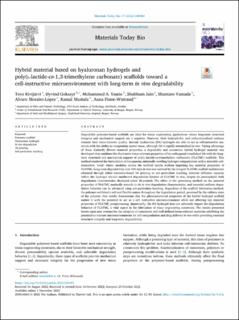| dc.contributor.author | Kivijärvi, Tove | |
| dc.contributor.author | Goksøyr, Øyvind | |
| dc.contributor.author | Yassin, Mohammed Ahmed Alamin Yousif | |
| dc.contributor.author | Jain, Shubham | |
| dc.contributor.author | Yamada, Shuntaro | |
| dc.contributor.author | Mustafa, Kamal Babikeir Elnour | |
| dc.contributor.author | Finne-Wistranda, Anna | |
| dc.date.accessioned | 2023-03-10T14:30:22Z | |
| dc.date.available | 2023-03-10T14:30:22Z | |
| dc.date.created | 2022-11-03T22:29:51Z | |
| dc.date.issued | 2022 | |
| dc.identifier.issn | 2590-0064 | |
| dc.identifier.uri | https://hdl.handle.net/11250/3057772 | |
| dc.description.abstract | Degradable polyester-based scaffolds are ideal for tissue engineering applications where long-term structural integrity and mechanical support are a requisite. However, their hydrophobic and unfunctionalized surfaces restrain their tissue-mimetic quality. Instead, hyaluronan (HA) hydrogels are able to act as cell-instructive materials with the ability to recapitulate native tissue, although HA is rapidly metabolized in vivo. Taking advantage of these distinctly diverse material properties, a degradable and concurrent hybrid hydrogel material was developed that combines the short-term tissue-relevant properties of bio-orthogonal crosslinked HA with the long-term structural and mechanical support of poly(l-lactide-co-trimethylene carbonate) (PLATMC) scaffolds. This method rendered the formulation of transparent, minimally swelling hydrogel compartments with a desirable cell-instructive “local” elastic modulus within the scaffold matrix without impeding key material properties of PLATMC. Long-term degradability over 180 days in vivo was realized by the integral PLATMC scaffold architecture obtained through either extrusion-based 3D printing or salt-particulate leaching. Intrinsic diffusion capacity within the hydrogel elicited unaffected degradation kinetics of PLATMC in vivo, despite its autocatalytic bulk degradation characteristics displayed when 3D-printed. The effect of the processing method on the material properties of PLATMC markedly extends to its in vivo degradation characteristics, and essential uniform degradation behavior can be advanced using salt-particulate leaching. Regardless of the scaffold fabrication method, the polymer exhibited a soft and flexible nature throughout the degradation period, governed by the rubbery state of the polymer. Our results demonstrate that the physicochemical properties of the hybrid hydrogel scaffold endow it with the potential to act as a cell instructive microenvironment while not affecting key material properties of PLATMC postprocessing. Importantly, the HA hydrogel does not adversely impact the degradation behavior of PLATMC, a vital aspect in the fabrication of tissue engineering constructs. The results presented herein open new avenues for the adoption of concurrent and well-defined tissue-relevant materials exhibiting the potential to recreate microenvironments for cell encapsulation and drug delivery in vivo while providing essential structural integrity and long-term degradability. | en_US |
| dc.language.iso | eng | en_US |
| dc.publisher | Elsevier | en_US |
| dc.rights | Navngivelse 4.0 Internasjonal | * |
| dc.rights.uri | http://creativecommons.org/licenses/by/4.0/deed.no | * |
| dc.title | Hybrid material based on hyaluronan hydrogels and poly(l-lactide-co-1,3-trimethylene carbonate) scaffolds toward a cell-instructive microenvironment with long-term in vivo degradability | en_US |
| dc.type | Journal article | en_US |
| dc.type | Peer reviewed | en_US |
| dc.description.version | publishedVersion | en_US |
| dc.rights.holder | Copyright 2022 the authors | en_US |
| dc.source.articlenumber | 100483 | en_US |
| cristin.ispublished | true | |
| cristin.fulltext | original | |
| cristin.qualitycode | 1 | |
| dc.identifier.doi | 10.1016/j.mtbio.2022.100483 | |
| dc.identifier.cristin | 2068965 | |
| dc.source.journal | Materials Today Bio | en_US |
| dc.identifier.citation | Materials Today Bio. 2022, 17, 100483. | en_US |
| dc.source.volume | 17 | en_US |

